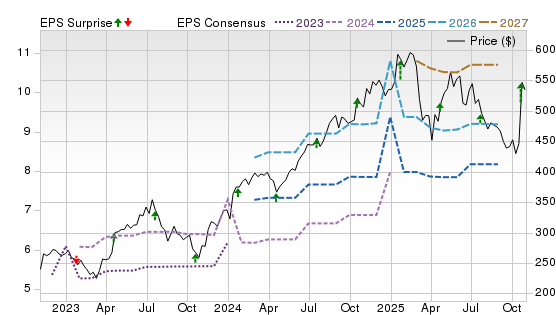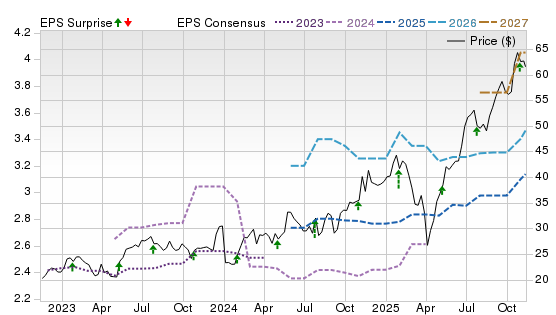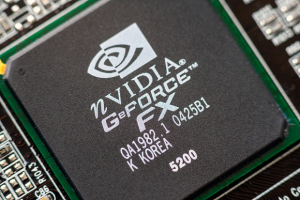5 Best AI Stocks to Buy Today
| Company (Ticker) | 12 Week Price Change | Forward PE | Price | Proj EPS Growth (1 Year) | Projected Sales Growth (1Y) |
|---|---|---|---|---|---|
| Micron Technology (MU) | 88.16% | 13.04 | $224.53 | 107.10% | 45.76% |
| Intuitive Surgical (ISRG) | 20.11% | 66.04 | $578.71 | 17.28% | 18.72% |
| Flex (FLEX) | 6.21% | 18.15 | $57.35 | 18.40% | 4.77% |
| Lam Research (LRCX) | 50.15% | 31.41 | $151.93 | 15.64% | 14.06% |
| Teradyne (TER) | 40.37% | 47.30 | $167.67 | 8.97% | 8.06% |
*Updated on November 25, 2025.
Micron Technology (MU)
$224.53 USD +0.60 (0.27%)
3-Year Stock Price Performance

Premium Research for MU
- Zacks Rank
- Strong Buy 1
- Style Scores
C Value A Growth A Momentum A VGM
- Market Cap: $251.73B (Large Cap)
- Projected EPS Growth:107.12%
- Last Quarter EPS Growth:65.32%
- Last EPS Surprise:5.94%
- Next EPS Report date:Dec. 17, 2025
Our Take:
Micron is a leading supplier of DRAM, NAND, and high-bandwidth memory that powers AI training and inference. Its HBM3E is qualified for NVIDIA accelerators and is now in volume production. Fundamentally, Micron is leveraged to the growth in AI servers via HBM and DDR5, a multiyear content story as model sizes expand and power efficiency matters more. Management’s execution on HBM ramps and customer wins positions it well as supply remains tight across the industry.
A Zacks Rank #1 (Strong Buy) underscores broad upward earnings revisions, while Style Scores of A for Growth and Momentum point to accelerating AI-driven fundamentals and strong price follow-through, while a score of C for Value suggests shares are no longer inexpensive but supported by an improving outlook.
On the Price, Consensus & EPS Surprise chart, price has surged alongside rising 2026–2027 EPS lines, with upside surprises followed by estimate bumps, an encouraging setup for sustained momentum.
Intuitive Surgical (ISRG)
$578.71 USD +10.23 (1.80%)
3-Year Stock Price Performance

Premium Research for ISRG
- Zacks Rank
 Strong Buy 1
Strong Buy 1
- Style Scores
F Value D Growth F Momentum F VGM
- Market Cap:$203.79B (Large Cap)
- Projected EPS Growth:17.30%
- Last Quarter EPS Growth: 7.10%
- Last EPS Surprise: 20.60%
- Next EPS Report date: Jan. 22, 2026
Our Take:
Intuitive develops the da Vinci and Ion robotic platforms; the newest da Vinci 5 was designed with AI and machine-vision capabilities, as well as deeper data analytics. Strategically, AI is seeping into the ecosystem via Case Insights and newly cleared AI-assisted navigation and imaging on Ion, expanding software leverage and clinical differentiation without requiring fully autonomous surgery. That mix supports recurring revenue and durable moats as health systems scale robotics.
A Zacks Rank #1 with Style Scores of F for Value and Momentum, and D for Growth flags a premium valuation and uneven recent trading, yet near-term estimate trends remain constructive as placements and procedure volumes expand. Management has pointed to robust adoption and a growing installed base, a key driver of recurring instrument revenue.
On the chart, shares trend higher while 2026–2027 EPS estimates stair-step up after positive surprises, which is consistent with a company converting data and installed base growth into rising profitability.
Flex (FLEX)
$57.35 USD +0.40 (0.70%)
3-Year Stock Price Performance

Premium Research for FLEX
- Zacks Rank
 Buy 2
Buy 2
- Style Scores
A Value B Growth A Momentum A VGM
- Market Cap:$21.06B (Large Cap)
- Projected EPS Growth:18.49%
- Last Quarter EPS Growth:9.38%
- Last EPS Surprise:5.33%
- Next EPS Report date:Feb. 4, 2026
Our Take:
Flex is a global design-to-manufacturing partner whose data-center and compute exposure positions it as a behind-the-scenes beneficiary of AI infrastructure build-outs. Flex highlights grid-to-chip power, cooling, and scalable IT infrastructure capabilities that help hyperscale customers solve AI’s heat, power, and deployment constraints, advantages few EMS peers can match. Its end-to-end footprint and vertical integration offer cost and speed benefits as AI server demand scales.
A Zacks Rank #2 (Buy) with Style Scores of A for Value and Momentum, and B for Growth suggests a reasonable entry with improving fundamentals and supportive price action. Flex’s collaboration with NVIDIA on modular “AI factories” further validates its role in accelerating hyperscale deployments.
The chart shows an uptrend with forward EPS lines rising for 2026–2027, consistent with pipeline wins in AI data-center hardware. That alignment between improving estimates and execution on cooling/power platforms backs the favorable Style Scores and Rank.
Lam Research (LRCX)
$151.93 USD +1.55 (1.03%)
3-Year Stock Price Performance

Premium Research for LRCX
- Zacks Rank
 Hold 3
Hold 3
- Style Scores
D Value A Growth B Momentum B VGM
- Market Cap:$188.88B (Large Cap)
- Projected EPS Growth:15.70%
- Last Quarter EPS Growth:-5.26%
- Last EPS Surprise:4.13%
- Next EPS Report date:Feb. 4, 2026
Our Take:
Lam is a top wafer-fab equipment vendor whose etch/deposition and advanced-packaging tools are critical to HBM, 3D NAND, and gate-all-around nodes that enable AI chips. Management and industry commentary point to rising tool demand as customers scale HBM and complex AI silicon over the next several years. Lam Research expects strong revenue growth on rising demand for chipmaking tools tied to AI processors. Recent outlooks highlight AI-linked WFE strength into 2026.
A Zacks Rank #3 (Hold), with Style Scores of A for Growth, D for Value, and B for Momentum, reflects strong secular drivers but a more balanced near-term setup after a sizable run.
The chart shows a strong price advance with meaningful upward inflections in out-year EPS estimates, signaling confidence in AI-linked orders. While equipment cycles can be choppy, Lam’s AI memory and packaging exposure support durability in the current upcycle.
Teradyne (TER)
$167.67 USD +1.70 (1.02%)
3-Year Stock Price Performance

Premium Research for TER
- Zacks Rank
 Buy 2
Buy 2
- Style Scores
D Value F Growth B Momentum F VGM
- Market Cap:$25.99B (Large Cap)
- Projected EPS Growth: 9.01%
- Last Quarter EPS Growth:49.12%
- Last EPS Surprise: 8.97%
- Next EPS Report date:Feb 4, 2026
Our Take:
Teradyne supplies automated test equipment that validates advanced AI chips and high-speed memory, making it a critical picks-and-shovels beneficiary of AI compute growth. It also owns Universal Robots and MiR in collaborative and mobile robotics. Recent results showed semiconductor test strength and management commentary tied demand to cloud-AI and memory markets.
A Zacks Rank #2 with Style Scores of D for Value, F for Growth, and B for Momentum suggests improving sentiment despite a richer multiple and uneven revisions. Structurally, AI and HBM complexity is increasing test intensity, a secular tailwind for leading ATE platforms.
The chart reveals volatility, but a recent breakout alongside firmer 2026–2027 EPS lines. That pattern of price strength confirming rising estimates supports the Rank, while AI-centric device mix and memory test demand provide catalysts for the next capex cycle.
Methodology
The Zacks Rank is a proprietary stock-rating model that uses trends in earnings estimate revisions and earnings-per-share (EPS) surprises to classify stocks into five groups: #1 (Strong Buy), #2 (Buy), #3 (Hold), #4 (Sell) and #5 (Strong Sell). The Zacks Rank is calculated through four primary factors related to earnings estimates: analysts' consensus on earnings estimate revisions, the magnitude of revision change, the upside potential and estimate surprise (or the degree in which earnings per share deviated from the previous quarter).
Zacks builds the data from 3,000 analysts at over 150 different brokerage firms. The average yearly gain for Zacks Rank #1 (Strong Buy) stocks is +23.62% per year from January, 1988, through June 2, 2025.
Selections for Best AI Stocks are based on the current top ranking stocks based on Zacks Indicator Score. For this list, only companies that have average daily trading volumes of 100,000 shares or more and at least five analysts covering the stock were considered. All information is current as of market open, Nov. 25, 2025.
Guide to AI Stocks
The classification of “AI Stocks” is actually quite broad, ranging from companies that provide the essential hardware, companies that create the software to run Large Language Models, and a whole host of other industries and companies that are creating the Artificial Intelligence ecosystem. All stand to gain – or lose – depending on the fortunes of AI tech.
Types of AI Stocks
Hardware (GPUs, Chips) Stocks – NVIDIA, AMD, TSMC, Broadcom
The backbone of AI is raw computing power, and this comes primarily from specialized chips like graphics processing units (GPUs) and AI-focused accelerators. NVIDIA (NVDA) is the undisputed leader in GPUs used for training large language models.
Advanced Micro Devices (AMD) is a rising competitor, with its MI300 series targeting data center AI workloads. Taiwan Semiconductor Manufacturing Co. (TSMC) doesn’t make its own chips but manufactures advanced nodes for nearly every big tech firm—including Apple, Nvidia, and AMD—making it critical to the global AI supply chain. Broadcom (AVGO) has carved a niche in custom ASICs (application-specific integrated circuits) for hyperscale cloud providers, which value tailored chips that reduce energy use and maximize throughput.
These companies benefit from structural demand for more computing capacity, but they also face geopolitical risks such as U.S.-China export restrictions and cyclical swings in semiconductor demand.
AI Cloud & Infrastructure – Microsoft, Amazon, Alphabet
Building AI applications at scale requires massive computing infrastructure. Azure from Microsoft (MSFT) has become a leader by integrating OpenAI’s models directly into its cloud offerings, giving it a first-mover advantage in AI enterprise adoption. Amazon Web Services, a subsidiary of Amazon (AMZN) is deploying its in-house Trainium and Inferentia chips, aiming to lower costs for AI workloads while retaining dominance in cloud services. Alphabet’s (GOOG) Google Cloud is leaning heavily on its proprietary Tensor Processing Units (TPUs) and Gemini AI models to differentiate itself.
Investing in these players is less about speculative growth and more about diversified tech giants whose AI investments bolster an already profitable core business.
Enterprise AI Software & Analytics – Palantir, C3.ai, Adobe, Snowflake
AI isn’t just about hardware; software platforms are where businesses actually apply machine intelligence. Palantir (PLTR) powers decision-making for defense and large corporations with its Foundry and Gotham platforms. C3.ai (AI) focuses specifically on AI-driven applications across industries like energy, finance, and manufacturing. Adobe (ADBE) has integrated AI across its creative suite (e.g., Firefly in Photoshop), while Snowflake (SNOW) has added AI-enabled analytics to its cloud data warehousing business.
These stocks tend to have higher growth potential but also higher risk, as adoption timelines and customer budgets can vary widely.
Cybersecurity AI – CrowdStrike
The rise of AI also heightens cyber risks. CrowdStrike (CRWD) leads in AI-powered threat detection, using machine learning to flag suspicious behavior across millions of endpoints in real time. With ransomware and nation-state attacks increasing, demand for AI-driven security remains strong. Cybersecurity names often benefit from recurring revenue models, which may help smooth out volatility compared to hardware peers.
Benefits and Risks of AI Stocks
Benefits:
- Secular Growth: AI adoption is still in early innings, with enterprise use cases expanding rapidly.
- Diversified Exposure: Investors can target infrastructure, software, or services depending on risk tolerance.
- First-Mover Advantage: Leaders like NVIDIA and Microsoft are shaping the ecosystem, creating strong economic moats.
Risks:
- Valuations: Many AI leaders are priced for perfection, leaving little margin of safety.
- Hype Cycle: Investor enthusiasm may outrun near-term fundamentals, creating bubble risk.
- Regulation: Governments are exploring AI rules around privacy, bias, and national security, which could reshape business models.
- Competition: Barriers to entry are high, but fast innovation means today’s leader can quickly lose ground.
How to Choose AI Stocks
When evaluating AI stocks, consider:
- Revenue Mix: How much of the company’s growth is truly driven by AI vs. traditional segments?
- Moat & Differentiation: Does the company control unique technology (like NVIDIA’s CUDA software ecosystem)?
- Customer Adoption: Look for companies with recurring contracts or wide adoption across industries.
- Financial Health: Strong balance sheets matter in a capital-intensive industry.
- Valuation Metrics: Compare price-to-earnings (P/E) ratio, price-to-sales (P/S) ratio, and forward growth projections to industry peers.
How to Invest in AI Stocks
There are multiple entry points depending on your goals:
- Direct Stock Picks: Best if you want concentrated exposure to specific company leaders or disruptors.
- AI Exchange-Traded Funds (ETFs): ETFs such as Global X Robotics & Artificial Intelligence ETF (BOTZ) or iShares Robotics and AI ETF (IRBO) provide diversification by investing in a broad range of companies in the AI space.
- Broad Tech ETFs: Like Invesco QQQ (QQQ) or Vanguard Information Technology ETF (VGT), offering AI exposure as part of a bigger tech basket.
- Dollar-Cost Averaging (DCA): A strategy to smooth price volatility by buying at regular intervals AI stocks or funds.
- Long-Term Holds: Since AI is a multi-decade trend, investors who can weather short-term swings may see the best results.
AI Stocks Alternatives
If you want exposure to AI without betting on a single stock:
- ETFs: Offer diversification and reduce single-company risk.
- Private Markets: Startups in robotics, generative AI, and enterprise AI could offer upside, though access is limited to accredited investors, which face income or licensing limitations (such as a net worth of $1 million, excluding primary residence, plus a high annual income – $300,000 if married.
- Picks-and-Shovels Plays: Companies supplying infrastructure, like power management (e.g., Eaton) or data center REITs (e.g., Equinix), benefit indirectly from AI growth.
Strategies for AI Stocks Moving Forward
- Barbell Approach: Combine stable mega-caps (Microsoft, Nvidia) with speculative names (Quantum Computing Inc., Credo) for balanced exposure.
- Rebalancing: Trim positions after strong rallies to lock in gains and redeploy into underweighted sectors.
- Monitor Earnings: Focus on whether AI adoption translates into sustainable revenue growth.
- Look Beyond the U.S.: Consider emerging AI leaders in Europe and Asia for diversification.
- Stay Agile: AI is evolving rapidly; reassess holdings every quarter as new winners emerge.
Frequently Asked Questions About AI Stocks
Are AI stocks overvalued?
Many AI leaders are priced at steep multiples compared to the broader market. That doesn’t mean all are bubbles, but investors should separate hype from earnings-driven growth.
What is the forecast for AI stocks?
Most analysts expect AI demand to expand through at least the next decade, with data center spending, AI-as-a-service, and AI-enabled enterprise tools driving revenue.
What metrics best signal AI efficacy?
- Growth in AI-specific revenue lines.
- Gross margin improvements tied to AI.
- Customer retention and expansion.
- Evidence of scale: Contracts, partnerships, recurring revenue.














